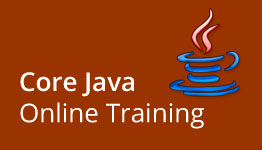About Core Java Online Training
Shiksha Tarang has another course in its kitty and this time around it is turn to catch up on Core Java as it has been making off even before we could get close to it! But not anymore... as with Shiksha Tarang on your side, you can make the most of it and go to the depths of the subjects!!! Read on...
Core Java Course Objectives:
The objectives of Core Java course are:
- Familiarize yourself with the characters of Java.
- Be at ease when working on –
- Classes,
- Inheritance,
- Interfaces,
- Objects,
- Polymorphism.
- Tailor made not only the Graphical User Interface or the GUI apps but also the Applets with the help of Swing and AWT.
- Develop –
- Networking Applications,
- Multithreaded Applications and
- Database employing the JDBC.
- Acquire knowledge of the Java API’s for I/O Streams as well as Collections.
- Unlock the code to write Java code as per the Object Oriented Programming Fundamentals.
Requirements from the Students End:
- Folks who have an inclination to become Java Developers can take up this course,
- Conversant with the essential Programming Techniques, notably C would be the icing on the cake.
- Even if you are unable to get through the Certification Exams... Shiksha Tarang’s Core Java is here to rescue you from the distress!!!
Core Java Online Course Summary
Part I:
Java’s Environment:
- Object Orientation
- Platform Independent
- Involuntary Memory Management
- Interpreted or Compiled Approaches
- Resilient
- Firm
- High Powered Linking
- Myriad Threads (Multithreaded)
- Ingrained Networking
Part II:
Crux of Java
- Types of the Data
- Operators
- Be in command of Statements
- Arrays
- Amplified for-loop
- Summarized Types
- Static Import
- Impromptu Boxing
- C-Styled Patterned I/O
- Variable Arguments
Part III:
Object Oriented Programming – the Ground Work:
- Define Object
- Class Definition
- Encapsulation finds its use to fuss both Data and Methods in a Class
- Inheritance
- Polymorphism
Part IV:
Composing Java Class:
- Encapsulation
- Inheritance
- Polymorphism
- Constructor
- OOP in Java
- Principles of a Class
- Making use of Objects
- Collecting the Junk
- Method Overriding
- Method Overloading
- Static Members
- Using Interface Class
- Mastering the Interface
Part V:
Packages:
- Packages – what are they and how are they used?
- Access the modifiers and their Scope
- Come in the know how category for the Classpath
Part VI:
Exception Handling:
- Exception Handling’s Significance
- Exception Genres
- Exception Propagation
- Take advantage of –
- Try,
- Catch,
- Throw,
- Lastly put the thoughts in words and Write down the User Defined Exceptions!
Part VII:
I/O Operations:
- File Handling
- Byte Oriented Streams
- Writers and Readers
Part VIII:
Programming – the Multithreaded Way!
- Fore – word on Multi-Threading
- Absorbing the meaning of Threads and it’s States
- Thread Class
- Runnable Interface
- Java Threading Replica
- Concerns of the Thread
- Threads put in sync
- Avert the Deadlocks
- Interthread Communication
Part IX:
Network Programming:
- Networking’s Preface
- Uniform Resource Locator or the URL
- InetAddress
- UDP Socket
- TCP Socket and Server Socket
Part X:
Collection Framework or the Java Util Package:
- Iterator and Collection Interface
- Enumeration
- List
- Array List
- Comparator
- Vector
- Set Interface
- Hash Table
- Sorted Set
- Properties
Part XI:
Generics?
- What is Generics???
- Operate the in - built Generics Collections
- Write Elementary Generic Class
- Wild Card Generics
- Bounded Generics
Part XII:
Inner Classes:
- Nested the top notch Classes
- Local Classes
- Member Classes
- Incognito Classes
Part XIII:
Intellectual Window Tool kit:
- Graphics
- Colour
- Font
- AWT Components
- AWT Controls
- Event Handling
- Event Presentation
Part XIV:
Swing Programming:
- Beginning of MVC and Swing Architecture
- Swing Hierarchy
- Feathery Component
- JFrame and JApplet are some of the Top Level Containers.
- Atomic Components like JButton, JList and more
- Intermediate Container such as JPanel, JSplitPane among others
- Events corresponding Swings.
Why Java after all?
We are very well aware that this Java Programming language has been evolved by the Sun Microsystems. And in turn has become a rage these days! To learn Java we should understand that -Java is one such Language which can run on “n” number of operating systems without giving any hitch to the User, as it adapts to the environment! In addition to this you will not have to write the program time and again for various operating systems!!!
How will Shiksha Tarang help me with Java?
At Shiksha Tarang, the Teaching is always a learning experience with the best in the industry coming all the way! The Students are mentored in a manner to develop a Java Program with no one to help! Timely assistance is another key feature at Shiksha Tarang...
The Future:
Hard work definitely pays off... so have a future where you can earn Rs.149, 176/- as a Fresher going up to Rs.726, 834/- per annum. (These are approx. Figures) the rest lies in your hand...
So jump start your Journey with a BANG!
Frequently Asked Questions
Reviews
Not reviewed yet
